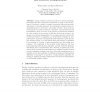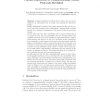392 search results - page 18 / 79 » Reversal Complexity Revisited |
APPROX
2007
Springer
14 years 1 months ago
2007
Springer
Abstract. A fundamental goal of computational complexity (and foundations of cryptography) is to find a polynomial-time samplable distribution (e.g., the uniform distribution) and...
RECOMB
2006
Springer
14 years 7 months ago
2006
Springer
Abstract. During evolution, genomes are subject to genome rearrangements that alter the ordering and orientation of genes on the chromosomes. If a genome consists of a single chrom...
GD
2004
Springer
14 years 27 days ago
2004
Springer
Pinchasi and Radoiˇci´c [11] used the following observation to bound the number of edges of a topological graph without a self-crossing cycle of length 4: if we make a list of t...
ICSM
2002
IEEE
14 years 13 days ago
2002
IEEE
One of the most critical issues in large-scale software development and maintenance is the rapidly growing size and complexity of software systems. As a result of this rapid growt...
TCC
2007
Springer
14 years 1 months ago
2007
Springer
Abstract. Parallel repetition is well known to reduce the error probability at an exponential rate for single- and multi-prover interactive proofs. Bellare, Impagliazzo and Naor (1...


